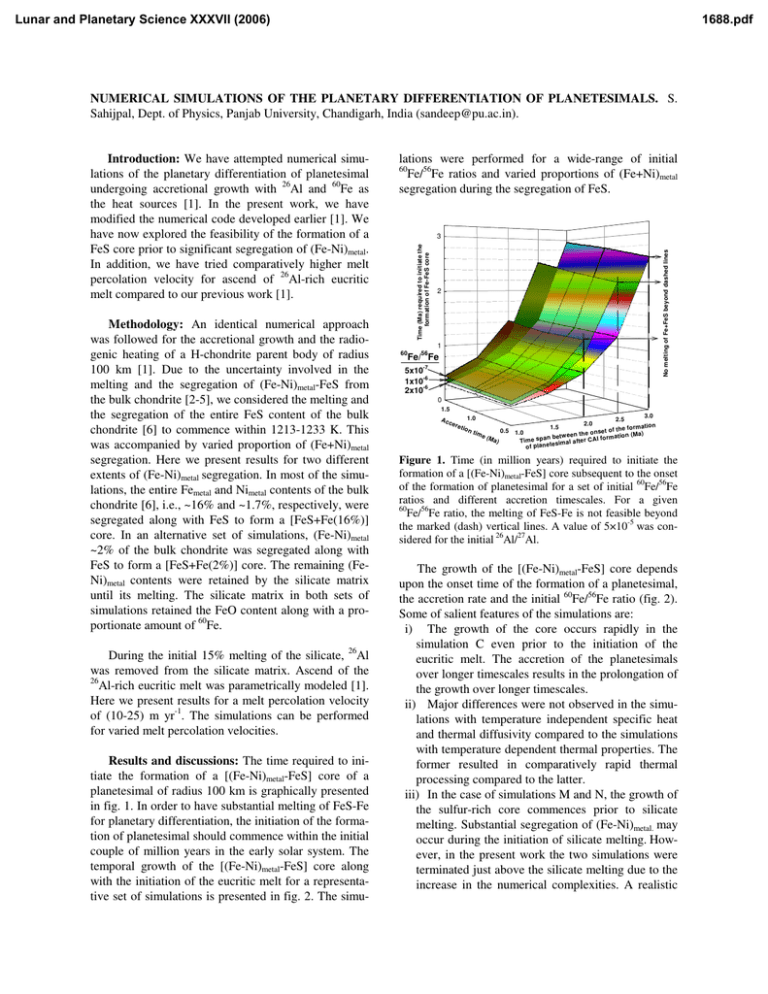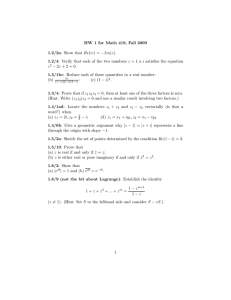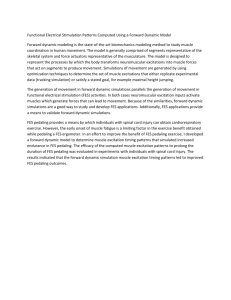NUMERICAL SIMULATIONS OF THE PLANETARY DIFFERENTIATION OF PLANETESIMALS. Introduction:
advertisement

Lunar and Planetary Science XXXVII (2006) 1688.pdf NUMERICAL SIMULATIONS OF THE PLANETARY DIFFERENTIATION OF PLANETESIMALS. S. Sahijpal, Dept. of Physics, Panjab University, Chandigarh, India (sandeep@pu.ac.in). During the initial 15% melting of the silicate, 26Al was removed from the silicate matrix. Ascend of the 26 Al-rich eucritic melt was parametrically modeled [1]. Here we present results for a melt percolation velocity of (10-25) m yr-1. The simulations can be performed for varied melt percolation velocities. Results and discussions: The time required to initiate the formation of a [(Fe-Ni)metal-FeS] core of a planetesimal of radius 100 km is graphically presented in fig. 1. In order to have substantial melting of FeS-Fe for planetary differentiation, the initiation of the formation of planetesimal should commence within the initial couple of million years in the early solar system. The temporal growth of the [(Fe-Ni)metal-FeS] core along with the initiation of the eucritic melt for a representative set of simulations is presented in fig. 2. The simu- 3 60 No melting of Fe+FeS beyond dashed lines Methodology: An identical numerical approach was followed for the accretional growth and the radiogenic heating of a H-chondrite parent body of radius 100 km [1]. Due to the uncertainty involved in the melting and the segregation of (Fe-Ni)metal-FeS from the bulk chondrite [2-5], we considered the melting and the segregation of the entire FeS content of the bulk chondrite [6] to commence within 1213-1233 K. This was accompanied by varied proportion of (Fe+Ni)metal segregation. Here we present results for two different extents of (Fe-Ni)metal segregation. In most of the simulations, the entire Femetal and Nimetal contents of the bulk chondrite [6], i.e., ~16% and ~1.7%, respectively, were segregated along with FeS to form a [FeS+Fe(16%)] core. In an alternative set of simulations, (Fe-Ni)metal ~2% of the bulk chondrite was segregated along with FeS to form a [FeS+Fe(2%)] core. The remaining (FeNi)metal contents were retained by the silicate matrix until its melting. The silicate matrix in both sets of simulations retained the FeO content along with a proportionate amount of 60Fe. lations were performed for a wide-range of initial 60 Fe/56Fe ratios and varied proportions of (Fe+Ni)metal segregation during the segregation of FeS. Time (Ma) required to initiate the formation of Fe-FeS core Introduction: We have attempted numerical simulations of the planetary differentiation of planetesimal undergoing accretional growth with 26Al and 60Fe as the heat sources [1]. In the present work, we have modified the numerical code developed earlier [1]. We have now explored the feasibility of the formation of a FeS core prior to significant segregation of (Fe-Ni)metal. In addition, we have tried comparatively higher melt percolation velocity for ascend of 26Al-rich eucritic melt compared to our previous work [1]. 2 1 Fe/56Fe 5x10-7 1x10-6 2x10-6 0 1.5 A cc e re 1.0 tio n tim e (M a 0.5 ) 3.0 2.5 2.0 1.5 rm atio n t of th e fo a) se 1.0 on e th betw een rm atio n (M Tim e sp an im al afte r CAI fo es of plan et Figure 1. Time (in million years) required to initiate the formation of a [(Fe-Ni)metal-FeS] core subsequent to the onset of the formation of planetesimal for a set of initial 60Fe/56Fe ratios and different accretion timescales. For a given 60 Fe/56Fe ratio, the melting of FeS-Fe is not feasible beyond the marked (dash) vertical lines. A value of 5×10-5 was considered for the initial 26Al/27Al. The growth of the [(Fe-Ni)metal-FeS] core depends upon the onset time of the formation of a planetesimal, the accretion rate and the initial 60Fe/56Fe ratio (fig. 2). Some of salient features of the simulations are: i) The growth of the core occurs rapidly in the simulation C even prior to the initiation of the eucritic melt. The accretion of the planetesimals over longer timescales results in the prolongation of the growth over longer timescales. ii) Major differences were not observed in the simulations with temperature independent specific heat and thermal diffusivity compared to the simulations with temperature dependent thermal properties. The former resulted in comparatively rapid thermal processing compared to the latter. iii) In the case of simulations M and N, the growth of the sulfur-rich core commences prior to silicate melting. Substantial segregation of (Fe-Ni)metal. may occur during the initiation of silicate melting. However, in the present work the two simulations were terminated just above the silicate melting due to the increase in the numerical complexities. A realistic Lunar and Planetary Science XXXVII (2006) 1688.pdf cretion scenario and the initial 60Fe/56Fe ratio, the initiation of the silicate melt can occur within the initial ~6 Ma and the melting can persist for a few million years. model may involve growth of a Fe-S core, subsequently followed by (Fe-Ni)metal segregation along with silicate melting. This model is beyond the scope of present work. The silicate melting was not observed in the simulation O. This simulation would result in the formation of a Fe-S core alone. iv) In order to have a substantial silicate melt, the accretion of a planetesimal should commence within the initial couple of million years. Based on the accretion scenario and the initial 60Fe/56Fe ratio, Fe/56 Fe Time span prior to the initiation of the planetesimal formation Time required to initate Fe-FeS melting FeS + Fe(16%) A B C D E F G H I J K L (Fe + FeS) core formation < 6 km 6 - 10 km 10 - 15 km 15 - 19 km 19 - 30 km 30 - 40 km 40 - 45 km Accretion time span of the planetesimal Simulation stopped Initiation of eucritic melt M N O P Q R S T U V W FeS + Fe(16%) 2x10 -6 FeS + Fe(2%) 1x10 -6 5x10 -7 60 References: [1] Sahijpal & Soni (2005) LPSC XXXVI Abstract # 1296 (CD-ROM). [2] Ghosh & McSween (1998) Icarus 134, 187. [3] Taylor (1993) Meteoritics 28, 34. [4] Rushmer et al. (2005) LPSC XXXVI Abstract # 1320 (CDROM). [5] Humayun et al. (2005) LPSC XXXVI Abstract # 2208 (CD-ROM). [6] Jarosewich (1990) Meteoritics 25, 323. 0 CAI Formation 1 2 3 4 5 6 7 8 9 10 Time (Ma) Figure 2. The temporal growth of a [Fe+FeS] core for a wide-range of simulation parameters. The black bars mark the !"time prior to the initiation of the formation of a planetesimal of radius 100 km. The symbol ( etion growth of the planetesimal. The multi-colored stacked bars (red through grey) represent the temporal growth of the [Fe+FeS] core size. The growth within a single color bar need not be linear with time. The symbol ( # ) represents the time of the initiation of the silicate melt. The simulations were terminated at the time marked by the symbol ( $ ).




